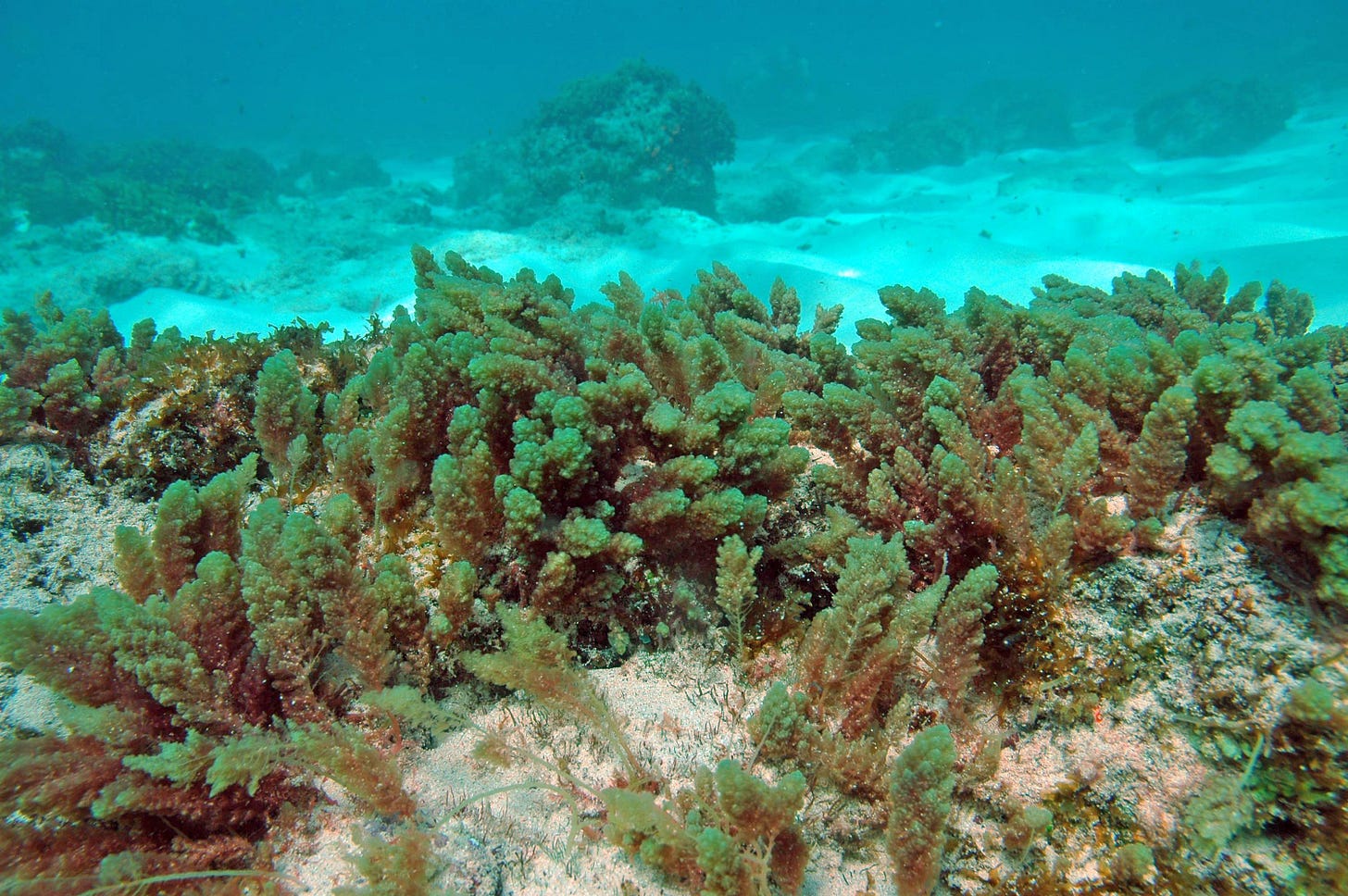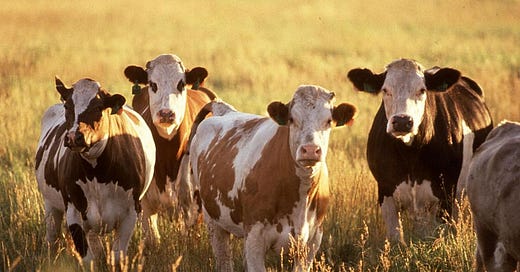How FutureFeed uses IP licensing to tackle the world's livestock emissions problem
Methane from domesticated animals causes more than 5% of all greenhouse gas emissions. Australia's FutureFeed may have the patents to solve the problem
FutureFeed released its Report to Industry 2023 this week, tracking the progress it and its partners have made in commercializing a technological innovation that promises to slash the agriculture sector’s emissions.
The Australian company holds foundational patents around the use of Asparagopsis, a genus of red seaweed, as an enteric methane inhibitor.
FutureFeed’s story-so-far provides an inspiring example of how a climatetech innovation with revolutionary potential has been successfully taken out of the lab and commercialized, thanks to some smart, strategic thinking around patents and other IP rights.
The company’s licensing model not only provides the possibility of a return on investment for it, its shareholders, and the original inventors of the technology; it is also sowing the seeds of a new methane-busting feed additive industry, providing numerous startups and entrepreneurs with a base on which they are building their own businesses and IP portfolios.
The problem with cow burps
The gastrointestinal tracts of ruminant animals like cattle and sheep produce methane as the result of enteric fermentation, a process by which their gut microbiota break down all those tough plants, grasses, and grains that farmers feed them.
Given that there are something like a billion cattle on the planet, plus another billion or so sheep, all of that enteric fermentation leads to a very significant amount of methane being burped into the atmosphere.
This contributes as much as 5.7% of total anthropogenic greenhouse gas emissions, according to the Intergovernmental Panel on Climate Change.
Feed with seaweed
Farmers in different parts of the world have been feeding seaweed to their herds since ancient times. The aquatic plants were often anecdotally said to lead to healthier and broodier animals, as well as higher meat and dairy yields.
It was in the course of testing some of these hypotheses that researchers discovered that certain seaweed varieties could reduce enteric methane when fed to ruminants.
This led to a research programme named FutureFeed run by Australia’s national research agency CSIRO and its partners James Cook University and Meat & Livestock Australia, which specifically looked at the most promising of these varieties.
Asparagopsis species — one of which is native to Australian waters — produce a bioactive compound called bromoform. This prevents the formation of methane in the ruminant gut by inhibiting a specific enzyme during digestion.
The FutureFeed programme ran trials in Australia and the USA to explore the efficacy of different types of the seaweed when added to animal feed in a variety of preparations and scenarios.
Results were promising: when added to cattle feed as a supplement, Asparagopsis appeared to reduce enteric methane production by around 80% depending on the dosage.
After demonstrating efficacy, the challenge would be scaling up the solution. The seaweed would need to be grown, processed, and distributed on a global scale if it was to fulfil its climate credentials.
Adopting a licensing model
FutureFeed was relaunched as a private company in August 2020 with A$13 million (US$9.34 million) in funding from CSIRO and four other founding investors: retail giant Woolworths, commodities handler GrainCorp, agrifood group Harvest Road, and accelerator operator AGP Sustainable Real Assets–Sparklabs Cultiv8 Joint Venture.
By forming a dedicated corporate entity, the plan was to take methane-busting feed additives to market by developing “a value chain from seaweed cultivation and production through to processing and feed manufacture to supply livestock producers,” according to CSIRO.
However, FutureFeed would not become an operating company in the sense that it’d take on these activities itself.
Instead, it would act as licensor, providing access to the foundational patents, knowhow, and other IP behind the technology so that third parties could run with it:
“The company will license seaweed growers… around the world to secure the ongoing delivery of high-quality seaweed, building the certified trademark and the standards that underpin it to build trust and credibility in the new industry, explore market options for monetizing the carbon benefits, and continue to support ongoing research and development.”
FutureFeed’s IP
In its industry report, FutureFeed states that it “holds the global intellectual property for the use of Asparagopsis as a livestock feed ingredient for reducing methane and holds granted patents and patent applications for a method of use for methane reduction, a method of use for productivity gains, and the process of manufacturing vegetable oil-based Asparagopsis products”.
My own search of global patent databases reveals that FutureFeed is the named owner of two patent families:
‘Novel composition’ - relating to “processes for preparing compositions suitable for reducing total gas production and/or methane production in a ruminant animal”.
Applications filed in Australia, Brazil, Canada, Chile, China, Europe, Israel, Japan, Mexico, South Africa, South Korea, UK, USA
Original document: Australian patent application AU2021102541A4
Filed 13th May 2021 as a divisional of AU2019394365; priority date 6th December 2018. Published 1st July 2021
Granted 17th February 2022
Original applicants: James Cook University; Pacific Biotechnologies (Australia) Pty Ltd
Assigned to FutureFeed Pty Ltd on 13th October 2022
Named inventors: Rocky De Nys; Marie Elisabeth Magnusson
‘Novel compositions for reducing methane production in ruminant animals’ - relating to “processes for preparing compositions comprising manufactured bromoform and a bromoform stabilizing excipient suitable for reducing total gas production and/or methane production and/or improving growth performance in a ruminant animal”.
Original document: worldwide patent application WO2023150832A1
Filed 9th February 2023, published 17th August 2023
Designated in multiple Patent Cooperation Treaty contracting states/regions
Original applicant: FutureFeed Pty Ltd
Named inventors: Robert Douglas Kinley; Breanna Michelle Roque; Siong Tan; Jessica Ellen Harris
Other than these two families, FutureFeed may be acting as licensor for further patents assigned to other entities. Citations made by the above applications offer some possibilities; for example:
‘Method for reducing total gas production and/or methane production in a ruminant animal’
Assignees: CSIRO; Meat & Livestock Australia; James Cook University
‘Growth performance improvements in pasture and feedlot systems’ - relating to “utilizing red marine macroalgae to provide improvements in growth performance of livestock, particularly ruminant animals”
Assignees: James Cook University; CSIRO; Meat & Livestock Australia
Then there’s IP beyond patents, such as the FutureFeed brand and the “certified trademark” mentioned above.
FutureFeed’s licensees
FutureFeed has signed nine licensees to date; all are involved in seaweed cultivation and processing, or animal feed. The report highlights the IP development activities that some of these licensees are themselves undertaking:
Blue Ocean Barns (locations: California and Hawai’i, USA; Mexico). The FutureFeed industry report says that “Blue Ocean Barns’ growing technology yields chemical compositions with patents pending” in multiple countries.
CH4 Global (South Australia; New Zealand). “All operations are land based, growing in patented vessels.” It has patented “methods for the cost effective growing and processing of Asparagopsis” and “several complementary methods that are widely used in commercial food production [which] reduce the loss of volatile bioactives, provide inherent stability, and reduce cost, waste, and energy use”.
CleanEyre Global (South Australia)
Immersion Group (Victoria and Western Australia, Australia; Japan; New Zealand). Its “[patented] technology optimizes growth rate, bromoform and cultivation density”.
Sea Forest (Tasmania, Australia)
SeaStock (Western Australia). Has developed “a patented dual extraction method for obtaining bromoform for use in canola and vegetable oils and natural pigments”.
Symbrosia (Hawai’i, USA). Has been “awarded a plant patent for a high-yield, high-resiliency, high-bromoform strain of Asparagopsis taxiformis”.
Synergraze (Alberta, Canada) has developed “a patent-pending extraction process to obtain a final methane-reducing cattle feed additive”.
Volta Greentech (Sweden)

Creating an industry around IP
FutureFeed’s new industry report claims that if just 10% of global cattle and sheep producers start using Asparagopsis feed supplements, it would have the same climate impact as removing 100 million cars from the world’s roads; while secondary increases in livestock productivity could create enough food for 23 million people.
Of course, it’s still early days for this technology. While FutureFeed and its partners continue to conduct studies into the efficacy and safety of their innovations, time will tell if these red seaweed supplements really can slash agricultural emissions. For a more prudent view on Asparagopsis and other enteric methane reduction technologies, read Tenacious Ventures partner Sarah Nolet’s thoughts here.
That said, the licensing model that FutureFeed and its partners are building around sets an example of how IP assets can be used to create not just new businesses, but a whole new value chain around academic and scientific research. As FutureFeed CEO Alex Baker says in its report, the potential benefits of the company’s IP extend beyond livestock agriculture and environmental impacts.
“Our licensees are growing and processing seaweed in the regions in which they operate, creating new industries and employment opportunities.”
“FutureFeed, together with our licensees, is creating a new, sustainable, nature-based industry.”
Read last week’s launch edition of AgriFoodIP here.



